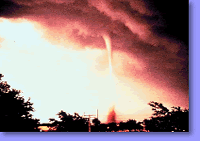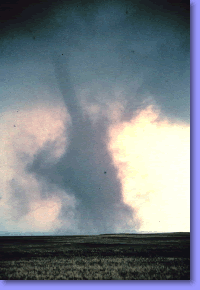T O R
N A D O E S
 Tornadoes
generate the most powerful winds on Earth, sometimes in excess of 300 miles
per hour, about twice as fast as those of hurricanes. In America each year there
are on average about 800 tornadoes, with over 80 deaths and 1,500 injuries.
In May 1999, an unusually violent set of tornadoes broke out in and around Oklahoma
City, killing nearly 50 people in one day. Researchers clocked winds at 318
mph, believed to be the fastest ever recorded. The largest number of tornadoes
ever recorded in a single outbreak was in April 1974 outbreak when 148 tornadoes
hit 13 states and parts of Canada killing 316 people in less than 24 hours.
Tornadoes
generate the most powerful winds on Earth, sometimes in excess of 300 miles
per hour, about twice as fast as those of hurricanes. In America each year there
are on average about 800 tornadoes, with over 80 deaths and 1,500 injuries.
In May 1999, an unusually violent set of tornadoes broke out in and around Oklahoma
City, killing nearly 50 people in one day. Researchers clocked winds at 318
mph, believed to be the fastest ever recorded. The largest number of tornadoes
ever recorded in a single outbreak was in April 1974 outbreak when 148 tornadoes
hit 13 states and parts of Canada killing 316 people in less than 24 hours.
Tornadoes
can occur on any day of the year and any place in the nation, but they are most
likely from April through June, and develop as you would expect from the nickname
most frequently up and down "Tornado Alley", the states of the Great
Plains including Kansas and Oklahoma, and from Northern Texas up to Illinois.
The southern states are more likely to experience tornadoes early in the year,
and northern states in later months. The United States has more tornadoes than
any place else on Earth, but they can also be found in Australia, Europe, Southern
Asia, especially Bangladesh and India, Africa and South America. 7 out of 10
tornadoes are relatively weak, with winds of less than 100 mph, and die out
very quickly, often without causing extensive damage. Winds in less than 2%
of tornadoes exceed 200 mph.
 Tornadoes
are spawned by violent thunderstorms, and also by hurricanes. They are
defined as being a funnel cloud stretching from the surface up into a storm.
They deliver a punch much less powerful than the total energy contained in the
whole thunderstorm or hurricane that gives birth to them, but what makes them
particularly deadly is that their energy is packed into a very small area. A
tornado may be the size of just a city block, less than half a kilometer,
Tornadoes
are spawned by violent thunderstorms, and also by hurricanes. They are
defined as being a funnel cloud stretching from the surface up into a storm.
They deliver a punch much less powerful than the total energy contained in the
whole thunderstorm or hurricane that gives birth to them, but what makes them
particularly deadly is that their energy is packed into a very small area. A
tornado may be the size of just a city block, less than half a kilometer, while a hurricane (like Floyd in 1999) may be the size of a state as large as
Texas. Most tornadoes last only minutes (though the May 99 Oklahoma tornadoes
lasted for 4 hours: the record is 7 hours!), while hurricanes endure for days
as they churn across the ocean and continue, while weakening, over coastal areas.
while a hurricane (like Floyd in 1999) may be the size of a state as large as
Texas. Most tornadoes last only minutes (though the May 99 Oklahoma tornadoes
lasted for 4 hours: the record is 7 hours!), while hurricanes endure for days
as they churn across the ocean and continue, while weakening, over coastal areas.
Within
that relatively small area of violent destruction, tornadoes kill by sucking
up heavy objects as large as cars and even trucks and railroad cars, and throwing
them, like heavy weapons, through buildings. That's why the most important safety
precaution is to TAKE SHELTER in basements or special shelters, and
NEVER to venture out when a tornado is forecast.
As
you'll see in the LIVE FROM THE STORM videos, NOAA's storm chasers
from the National Severe Storms Laboratory (NSSL) in Norman, OK, are
extremely careful even as they try to gather the detailed information that is
essential to make tornado predictions more reliable and provide longer lead
time for people to take cover. One of the most important tools in understanding
what actually triggers tornadoes (which the researchers call "tornado genesis",
the birth of tornadoes) from thunderstorms is Doppler radar. Tornado
warnings can now be given as much as 30 minutes in advance, thanks to researchers'
recognition of key warning signs that a tornado is likely. They hope to make
that lead time one hour as they study tornadoes more with the latest tools,
and understand them better.
As
you might also guess from the fact that they are called "twisters" (and
yes, the feature movie "Twister" was based in part on the research done at NSSL),
what triggers tornadoes is a very special set of circumstances that set
air violently rotating.

 Tornadoes
generate the most powerful winds on Earth, sometimes in excess of 300 miles
per hour, about twice as fast as those of hurricanes. In America each year there
are on average about 800 tornadoes, with over 80 deaths and 1,500 injuries.
In May 1999, an unusually violent set of tornadoes broke out in and around Oklahoma
City, killing nearly 50 people in one day. Researchers clocked winds at 318
mph, believed to be the fastest ever recorded. The largest number of tornadoes
ever recorded in a single outbreak was in April 1974 outbreak when 148 tornadoes
hit 13 states and parts of Canada killing 316 people in less than 24 hours.
Tornadoes
generate the most powerful winds on Earth, sometimes in excess of 300 miles
per hour, about twice as fast as those of hurricanes. In America each year there
are on average about 800 tornadoes, with over 80 deaths and 1,500 injuries.
In May 1999, an unusually violent set of tornadoes broke out in and around Oklahoma
City, killing nearly 50 people in one day. Researchers clocked winds at 318
mph, believed to be the fastest ever recorded. The largest number of tornadoes
ever recorded in a single outbreak was in April 1974 outbreak when 148 tornadoes
hit 13 states and parts of Canada killing 316 people in less than 24 hours.
 Tornadoes
are spawned by violent thunderstorms, and also by hurricanes. They are
defined as being a funnel cloud stretching from the surface up into a storm.
They deliver a punch much less powerful than the total energy contained in the
whole thunderstorm or hurricane that gives birth to them, but what makes them
particularly deadly is that their energy is packed into a very small area. A
tornado may be the size of just a city block, less than half a kilometer,
Tornadoes
are spawned by violent thunderstorms, and also by hurricanes. They are
defined as being a funnel cloud stretching from the surface up into a storm.
They deliver a punch much less powerful than the total energy contained in the
whole thunderstorm or hurricane that gives birth to them, but what makes them
particularly deadly is that their energy is packed into a very small area. A
tornado may be the size of just a city block, less than half a kilometer, while a hurricane (like Floyd in 1999) may be the size of a state as large as
Texas. Most tornadoes last only minutes (though the May 99 Oklahoma tornadoes
lasted for 4 hours: the record is 7 hours!), while hurricanes endure for days
as they churn across the ocean and continue, while weakening, over coastal areas.
while a hurricane (like Floyd in 1999) may be the size of a state as large as
Texas. Most tornadoes last only minutes (though the May 99 Oklahoma tornadoes
lasted for 4 hours: the record is 7 hours!), while hurricanes endure for days
as they churn across the ocean and continue, while weakening, over coastal areas.